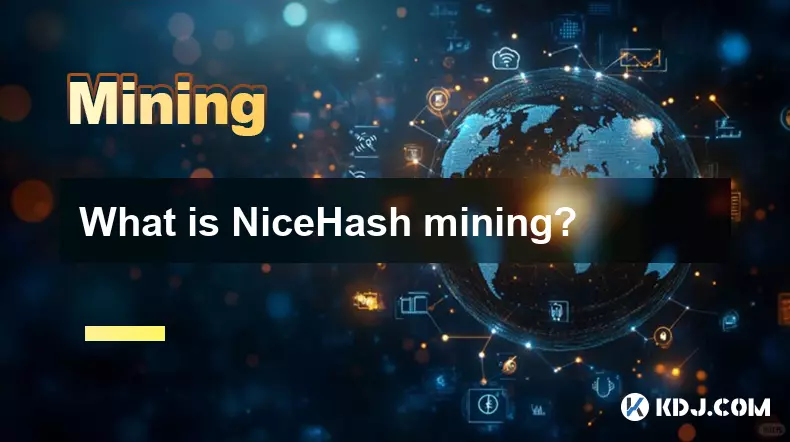-
 bitcoin
bitcoin $105968.894684 USD
4.17% -
 ethereum
ethereum $3639.320047 USD
7.62% -
 tether
tether $1.000339 USD
0.06% -
 xrp
xrp $2.407774 USD
5.96% -
 bnb
bnb $1011.704193 USD
2.28% -
 solana
solana $166.942754 USD
6.37% -
 usd-coin
usd-coin $1.000143 USD
0.03% -
 tron
tron $0.291515 USD
0.25% -
 dogecoin
dogecoin $0.181682 USD
4.06% -
 cardano
cardano $0.585450 USD
4.54% -
 hyperliquid
hyperliquid $42.099968 USD
5.20% -
 chainlink
chainlink $16.160745 USD
5.45% -
 zcash
zcash $645.269648 USD
12.96% -
 bitcoin-cash
bitcoin-cash $507.430338 USD
2.80% -
 stellar
stellar $0.290357 USD
3.69%
How to set up your first mining rig?
Choose the right GPU or ASIC for your coin, assemble a stable rig with proper cooling, install efficient software, join a mining pool, and monitor performance to maximize profitability.
Nov 05, 2025 at 08:20 pm

Choosing the Right Hardware Components
1. Select a high-performance GPU or ASIC based on the cryptocurrency you intend to mine. For Ethereum and similar coins, powerful GPUs like NVIDIA RTX 3080 or AMD RX 6700 XT are widely used. For Bitcoin, ASIC miners such as Bitmain Antminer S19 series dominate the market due to their efficiency.
2. Use a reliable motherboard that supports multiple GPUs if building a multi-card rig. The ASRock H110 Pro BTC+ is specifically designed for mining and supports up to seven graphics cards.
3. Choose a power supply unit (PSU) with sufficient wattage and 80 Plus certification. A 1000W or higher PSU is recommended for rigs with several GPUs to ensure stable operation under load.
4. Install a compatible CPU and at least 4GB of RAM. Mining does not require high-end processors, so budget options like Intel Celeron or Pentium are sufficient.
5. Use an inexpensive SSD or even a USB flash drive to install the operating system. Mining software doesn’t demand much storage, making large drives unnecessary.
Assembling the Mining Rig
1. Set up the motherboard on a non-conductive surface, preferably inside a dedicated mining frame. Secure all components including CPU, RAM, and storage device.
2. Install each GPU using PCIe riser cables. These extension cables allow vertical mounting and improve airflow. Ensure each riser is properly connected to both the motherboard and PSU.
3. Connect the PSU to all GPUs and the motherboard. Double-check all power connections, especially the 6-pin or 8-pin PCIe power inputs on each graphics card.
4. Attach cooling fans to maintain optimal temperature. Mining generates substantial heat, so adequate ventilation is critical to prevent thermal throttling or hardware damage.
5. Power on the system and verify that all GPUs are detected in the BIOS or during boot-up. Listen for unusual noises and check for error messages indicating faulty connections.
Configuring Software and Connecting to a Pool
1. Install a lightweight OS such as Windows 10 or a Linux distribution optimized for mining, like HiveOS. HiveOS offers remote management and monitoring features ideal for miners.
2. Download and install mining software compatible with your hardware and target coin. Popular choices include PhoenixMiner for Ethereum, CGMiner for ASICs, and GMiner for various GPU-mineable algorithms.
3. Create a wallet address for the cryptocurrency you are mining. Use trusted platforms like MetaMask for ERC-20 tokens or a native wallet for coins like Monero.
4. Join a mining pool to increase the consistency of rewards. Pools like Ethermine, F2Pool, or Slush Pool combine computational power from multiple miners to solve blocks more reliably.
5. Configure the miner settings with your wallet address, pool URL, and worker name. Test the configuration for stability and monitor hash rate and rejected shares through the pool’s dashboard.
Monitoring Performance and Maintenance
1. Use built-in tools or third-party software to track temperature, fan speed, and power consumption. Overheating can reduce efficiency and shorten hardware lifespan.
2. Clean dust from GPUs, risers, and fans regularly. Accumulated debris restricts airflow and increases operating temperatures.
3. Update firmware and mining software periodically to benefit from performance improvements and security patches. Outdated versions may suffer from bugs or reduced hashrates.
4. Watch for signs of failing hardware, such as crashing, artifacting on screen, or sudden drops in hash rate. Replace defective components promptly to avoid downtime.
5. Keep records of electricity usage and earnings to evaluate profitability. Electricity costs can quickly erode margins if not carefully managed.
Frequently Asked Questions
What is the most profitable cryptocurrency to mine with GPUs?Currently, Ravencoin and Ergo are among the most profitable GPU-mineable coins, largely due to their resistance to ASIC dominance and active community support.
How much does it cost to run a six-GPU mining rig?A typical six-GPU rig consumes around 1200–1500 watts under load. At $0.10 per kWh, daily electricity cost ranges between $2.88 and $3.60, depending on local rates and efficiency.
Can I use my mining rig for gaming or other tasks?While technically possible, mining rigs are optimized for parallel processing and often lack essential components like sound cards or sufficient cooling for sustained gaming workloads. Repurposing them may require significant modifications.
Do mining pools charge fees?Yes, most pools deduct a small percentage—typically 0.5% to 2%—from your earnings as a service fee. Some operate on a PPLNS (Pay Per Last N Shares) model, which rewards miners based on recent contribution rather than total shares.
Disclaimer:info@kdj.com
The information provided is not trading advice. kdj.com does not assume any responsibility for any investments made based on the information provided in this article. Cryptocurrencies are highly volatile and it is highly recommended that you invest with caution after thorough research!
If you believe that the content used on this website infringes your copyright, please contact us immediately (info@kdj.com) and we will delete it promptly.
- Zcash Price Prediction: Will the ZEC Breakout Continue?
- 2025-11-10 18:45:01
- XRP Price, AlphaPepe, and Predictions: What's the Buzz?
- 2025-11-10 18:55:01
- Crypto Explode: News Insights for Savvy Investors
- 2025-11-10 19:10:01
- XRP Price Rockets Amid ETF Buzz, Zcash Mimics Moonshot: A Breakdown
- 2025-11-10 19:10:01
- SaaS, Non-Human Identities, and User Authenticity: A New Era of Risk
- 2025-11-10 19:15:01
- BTC Treasury Bottom? Chanos Closes MSTR Short, Dogecoin Hints at Rebound
- 2025-11-10 19:40:02
Related knowledge

What is the block reward in mining?
Nov 06,2025 at 12:35am
Understanding Block Rewards in Cryptocurrency Mining1. The block reward is the incentive miners receive for successfully validating and adding a new b...

How do mining algorithms work?
Nov 06,2025 at 04:59am
Mining Algorithms and Their Role in Blockchain Networks1. Mining algorithms serve as the backbone of blockchain consensus mechanisms, ensuring that tr...

What is NiceHash mining?
Nov 06,2025 at 07:40am
NiceHash mining refers to the process of renting out computational power to individuals or organizations seeking to mine cryptocurrencies without owni...

Does an antivirus program affect mining?
Nov 05,2025 at 09:29pm
Understanding Decentralized Exchanges in the Crypto Ecosystem1. Decentralized exchanges (DEXs) operate without a central authority, allowing users to ...

What is the history of Bitcoin mining?
Nov 05,2025 at 08:15pm
Within the fast-moving world of cryptocurrency, new developments emerge daily, reshaping how investors, developers, and institutions interact with dig...

How is the energy consumption of mining justified?
Nov 05,2025 at 10:20pm
Energy Consumption in Cryptocurrency Mining1. The energy consumption associated with cryptocurrency mining has drawn significant attention from enviro...

What is the block reward in mining?
Nov 06,2025 at 12:35am
Understanding Block Rewards in Cryptocurrency Mining1. The block reward is the incentive miners receive for successfully validating and adding a new b...

How do mining algorithms work?
Nov 06,2025 at 04:59am
Mining Algorithms and Their Role in Blockchain Networks1. Mining algorithms serve as the backbone of blockchain consensus mechanisms, ensuring that tr...

What is NiceHash mining?
Nov 06,2025 at 07:40am
NiceHash mining refers to the process of renting out computational power to individuals or organizations seeking to mine cryptocurrencies without owni...

Does an antivirus program affect mining?
Nov 05,2025 at 09:29pm
Understanding Decentralized Exchanges in the Crypto Ecosystem1. Decentralized exchanges (DEXs) operate without a central authority, allowing users to ...

What is the history of Bitcoin mining?
Nov 05,2025 at 08:15pm
Within the fast-moving world of cryptocurrency, new developments emerge daily, reshaping how investors, developers, and institutions interact with dig...

How is the energy consumption of mining justified?
Nov 05,2025 at 10:20pm
Energy Consumption in Cryptocurrency Mining1. The energy consumption associated with cryptocurrency mining has drawn significant attention from enviro...
See all articles





















![The Graph Price Prediction [GRT Crypto Price News Today] The Graph Price Prediction [GRT Crypto Price News Today]](/uploads/2025/11/07/cryptocurrencies-news/videos/690d4df44fe69_image_500_375.webp)




















































